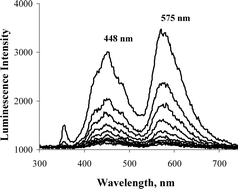Surface photochemistry: benzophenone as a probe for the study of silica and reversed-phase silica surfaces†
Abstract
This work reports the use of benzophenone, a very well characterized probe, to study new hosts: two reversed-phase silicas. Laser-induced room temperature luminescence of argon purged solid powdered samples of benzophenone adsorbed onto the two different reversed-phase silicas, RP-18 and RP-8, revealed the existence of a low energy emission band in contrast with the benzophenone adsorbed on 60 Å pore silica, where only triplet benzophenone emits. This low energy emission band was identified as the fluorescence of the ketyl radical of benzophenone, which is formed as the result of a hydrogen atom abstraction reaction of the triplet excited benzophenone from the alkyl groups of the surface of the reversed silicas. Such emission does not exist for benzophenone adsorbed onto 60 Å pore silica. Room temperature phosphorescence was obtained in argon purged samples for all the surfaces under use. The decay times of the benzophenone emission vary greatly with the alkylation of the silica surface when compared with “normal” silica surface. A lifetime distributions analysis has shown that the shortest lifetimes for the benzophenone emission exist in the former case. Triplet–triplet absorption of benzophenone was detected in all cases and is the predominant absorption in the case of 60 Å pore silica, while benzophenone ketyl radical formation occurs in the case of the reversed silicas. Diffuse reflectance laser flash photolysis and gas chromatography-mass spectrometry techniques provided complementary information, the former about transient species and the latter regarding the final products formed after laser irradiation, both at 266 nm or 355 nm. Product analysis and identification show that the degradation photoproducts are dependent on the excitation wavelength, the photochemistry being much more rich and complex in the 266 nm excitation case, where an α-cleavage reaction occurs. A detailed mechanistic analysis is proposed.


 Please wait while we load your content...
Please wait while we load your content...